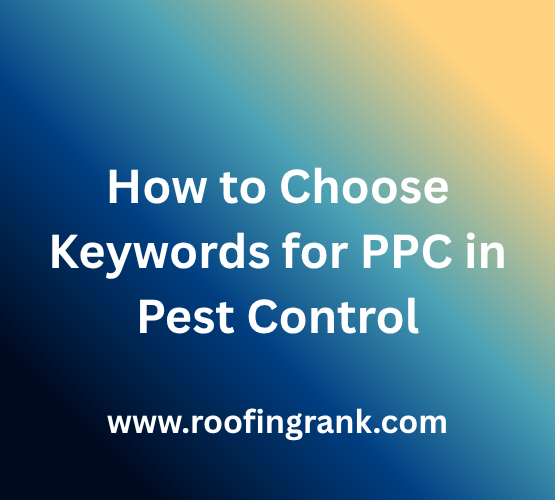How to Choose Keywords for PPC in Pest Control
Pay-per-click (PPC) advertising is one of the fastest and most measurable ways to bring qualified leads to a pest control business. But the heart of every successful PPC campaign lies in one critical aspect—keywords. The right keyword selection can be the difference between attracting high-intent customers or wasting budget on irrelevant clicks.
Pest control industry, where urgency and location-specific needs are paramount, keyword strategy must go beyond simple search volume metrics. You need to understand how your target audience searches, what services they require most, and how to align your keyword selection with buying intent. In this guide, we’ll walk through how to strategically choose PPC keywords for pest control services—step by step.
Understand the Intent Behind Pest Control Searches
Before diving into tools and keyword types, you must begin by evaluating search intent. There are three primary types of intent: informational, navigational, and transactional. For PPC in pest control, your focus should be on transactional and commercial investigation searches—keywords used by people actively looking to hire a pest control company.
For example, someone searching “bed bug exterminator near me” is a high-intent user, likely looking to book service soon. Compare that with someone searching “how to get rid of bed bugs naturally”—which is more informational and might not convert well through PPC. Identifying intent helps you avoid wasting ad spend on keywords that draw unqualified traffic.
Segment Your Services Before Choosing Keywords
Pest control businesses typically offer multiple services: rodent control, termite inspection, mosquito treatment, bed bug removal, and more. It’s a mistake to group all services under one broad campaign. Instead, segment your PPC strategy based on specific service lines. For each service category, build a dedicated keyword list.
Someone looking for termite inspection may not care about rodent removal—and Google’s Quality Score system rewards relevance. Use this segmentation in your ad copy, landing pages, and keyword selections. This targeted approach improves click-through rate, reduces bounce rate, and ultimately increases conversions.
Start With Broad Brainstorming: Think Like a Customer
Put yourself in the shoes of your target customers. What would they type in if they had a pest problem? Brainstorm terms without tools at first. Think of various customer pain points and local phrases. Write down service-specific keywords like “ant exterminator,” “wasp nest removal,” “termite treatment,” or “rat control services.” Don’t forget urgency-related terms like “same day pest control” or “emergency rodent removal.” Consider seasonal issues too—such as “mosquito control in summer.” This raw list becomes your base to refine and expand using keyword tools later.
Use Google Keyword Planner for Volume and Cost Insights
Google’s Keyword Planner remains the go-to tool for identifying keyword opportunities in PPC. It provides estimated monthly search volumes, competition levels, and suggested bid prices for each keyword. Enter your brainstormed keywords and explore related terms Google recommends. Pay attention to the following:
- High volume + high competition: These are often expensive but high-performing keywords like “exterminator near me.”
- Mid-volume + medium competition: Great for striking a balance between cost and conversions.
- Low-volume + low competition: These are long-tail gems—more on those shortly.
Use these insights to build different match types and ad groups. Google Keyword Planner also allows geographic targeting, so you can analyze keywords by city or zip code, which is essential for local pest control businesses.
Focus on Geo-Targeted Keywords to Attract Local Clients
Since pest control services are location-specific, geo-targeted keywords are essential for PPC success. This means adding city names, neighborhoods, or zip codes to your main keywords. For example:
- “Pest control in Austin”
- “Bed bug exterminator Chicago IL”
- “Rodent removal downtown Miami”
Geo-targeted keywords drive more qualified leads because people tend to search for pest control in their immediate area. You can even create multiple ad groups for different locations you serve. Tools like Google Trends or Ahrefs also help evaluate demand fluctuations by region. Use dynamic keyword insertion (DKI) for ad relevancy and make sure your landing pages include matching location terms.
Categorize Keywords Based on Match Types
Google Ads allows different match types that control how closely a user’s search must match your keyword. Each has its role in a pest control PPC campaign:
- Broad Match: Reaches a wide audience but can result in irrelevant clicks.
- Phrase Match: Shows ads to people searching for your keyword phrase in that order.
- Exact Match: Only shows ads to users who type in your exact keyword.
- Broad Match Modifier (now deprecated but still conceptually useful): Previously allowed partial matching using “+” symbols.
For example:
- Broad Match: pest control
- Phrase Match: “pest control services”
- Exact Match: [pest control in New York]
Start with phrase and exact match to control budget and monitor quality. Once you have data, you can experiment with broad match, accompanied by strict negative keywords.
Prioritize Long-Tail Keywords for Higher Intent
Long-tail keywords are longer, more specific phrases that often have lower search volume but much higher intent. Instead of “pest control,” a long-tail keyword would be “affordable spider exterminator in Dallas.” These queries usually indicate the person is closer to hiring and is more specific about their need. Long-tail keywords are also less competitive and more cost-effective. In pest control PPC, they can drastically improve conversion rates. Build a separate campaign or ad group for long-tail terms and test performance with smaller budgets.
Include Negative Keywords to Avoid Wasting Budget
Negative keywords prevent your ads from showing for irrelevant searches. For pest control, you might want to exclude terms like:
- “DIY pest control”
- “Free pest removal”
- “Homemade ant killer”
- “Pest control jobs”
Without negative keywords, you risk showing up for searches that don’t convert, which wastes budget. Use Google’s search terms report to discover what real users typed to trigger your ads. Identify unqualified phrases and add them to your negative keyword list regularly.
Analyze Competitors’ PPC Strategies
You can learn a lot from analyzing competitors who are already advertising in your area. Use tools like SEMrush, Ahrefs, or SpyFu to spy on which keywords they’re bidding on, what their ad copy looks like, and what landing pages they direct traffic to. This helps identify gaps in your own strategy or discover keywords you might not have considered. If a competitor is running ads on “organic pest control service,” and you offer that service too, it might be a profitable keyword to target.
Use Google Search Terms Report to Refine Keywords
Once your ads are live, one of your most powerful tools is the search terms report inside Google Ads. It shows exactly what users typed before clicking your ad. Review this data weekly. You’ll often find new keyword ideas that convert well or terms that should be added as negatives. This ongoing analysis lets you refine and improve your keyword targeting over time, increasing efficiency and reducing wasted spend.
Consider Seasonality and Pest Trends in Keyword Choice
Pest issues often vary by season. For example, termite and mosquito problems spike in summer while rodents are more of a winter concern. Use seasonal insights to plan your PPC campaigns and adjust keywords accordingly. Google Trends and historical campaign data help identify when to increase budgets or switch focus. You might run aggressive campaigns for “mosquito treatment” from May to August and then switch to “mice extermination” from November to February.
Align Keywords With Ad Copy and Landing Pages
Google’s Quality Score takes into account how relevant your ad and landing page are to the keyword. A high score reduces your cost per click and improves ad position. If you’re bidding on “bed bug exterminator Manhattan,” then that exact phrase should appear in your ad headline, description, and the corresponding landing page. Match the user’s search intent and location as closely as possible throughout the experience. This boosts relevance, increases click-through rate, and improves conversions.
Set Up Keyword Testing and A/B Experiments
PPC success in pest control isn’t a set-and-forget task. You need to run continuous A/B tests to find winning combinations. Test different versions of ad copy, landing pages, and keyword match types. Compare two ad groups bidding on the same keywords—one using phrase match and the other using exact match. See which delivers better conversion rates. Over time, use performance data to pause underperforming keywords and scale up what’s working.
Track Keyword Performance with Conversion Metrics
While click-through rate (CTR) and impressions are useful, your ultimate focus should be on conversion metrics. Track how many leads each keyword generates and how much each lead costs. Use call tracking numbers and form submission tracking to tie leads back to specific keywords. Google Ads conversion tracking or Google Analytics (with goal setup) can help you map performance clearly. Adjust budgets and bids based on performance—not just volume.
Build Branded Campaigns Alongside Service-Based Keywords
In addition to service and location-based keywords, run branded PPC campaigns using your company’s name. Branded keywords like “Acme Pest Control Miami” usually have high Quality Scores and low costs. This ensures you dominate the top spot even if someone else is bidding on your brand. Branded campaigns also reinforce trust and help convert repeat or referred visitors who are searching your name directly.
Combine Keywords with Extensions and Call Features
To improve click performance, use keyword-relevant ad extensions in Google Ads. Site link extensions, callout extensions, and structured snippets increase visibility and engagement. For pest control PPC, call extensions are especially important. Add phone numbers that match your service area and align them with urgent search keywords. For example, an ad for “emergency pest removal” should display a clickable phone number for immediate contact.
Final Thoughts: A Strategic Keyword Approach Pays Off
PPC campaigns in the pest control industry can drive consistent leads—but only when your keyword strategy is intentional and regularly optimized. The goal isn’t just to appear for “pest control” but to appear for the right terms—those that match the customer’s service need, urgency, and location. Focus on intent, structure campaigns by service, use long-tail and geo-targeted keywords, and stay vigilant with negative keywords. Use search term data to adjust your campaigns over time and watch performance improve steadily.
Keywords Selection Checklist for Pest Control PPC
Here’s a quick checklist to follow:
- ✅ Define service-specific categories (termites, bed bugs, rodents, etc.)
- ✅ Understand intent behind each keyword
- ✅ Use Google Keyword Planner and competitor tools
- ✅ Focus on long-tail, location-based phrases
- ✅ Apply proper match types (start with phrase and exact)
- ✅ Regularly update negative keywords
- ✅ Optimize ad copy and landing pages for each keyword
- ✅ Use seasonality insights to plan campaigns
- ✅ Track conversions, not just clicks
- ✅ Continuously test and refine
Need Expert Help with Your Pest Control PPC Campaign?
Choosing the right keywords for your pest control PPC campaign can transform your business. If you want professional keyword research, campaign setup, and ongoing optimization, reach out to our PPC experts. Let us help you drive high-quality leads and grow your business with precision.






